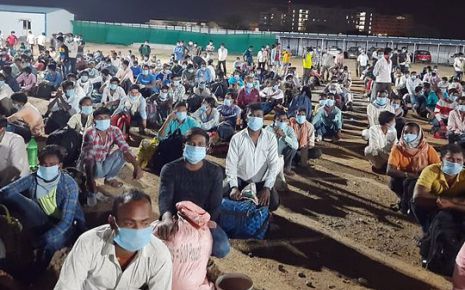Occupational Safety, Health And Working Conditions (OSH) Code, 2020: A New Era Of Worker Protection In India
The Occupational Safety, Health and Working Conditions Code, 2020 (OSH Code) is
a comprehensive piece of legislation introduced by the Indian government to
streamline and consolidate the laws relating to occupational safety, health, and
working conditions in India. The code was enacted on September 28, 2020, and
replaces 13 existing laws related to occupational health and safety in India.
The primary objective of the OSH Code is to ensure the safety, health, and welfare of all workers in India, including those in the organized and unorganized sectors. The code aims to achieve this by setting out standards and guidelines for various aspects of working conditions, including working hours, leave entitlements, social security, and welfare measures for workers. Additionally, the code establishes provisions for occupational safety and health, including the prevention and management of occupational accidents and diseases, the provision of first aid, and the promotion of workplace health and safety.
Worker protection is of paramount importance in India as the country has a large workforce in both the organized and unorganized sectors. The working conditions for many workers, especially those in the unorganized sector, are often poor, and they face significant challenges in accessing basic workplace protections. The OSH Code aims to address these challenges and provide a more comprehensive and effective framework for ensuring worker protection in India.
The code provides provisions for working hours, overtime, and leave entitlements, including a maximum of 8 hours of work per day, a weekly day off, and a minimum of 12 days of annual leave. Social security provisions such as medical, disability, and maternity benefits are also included.
Occupational safety and health committees are established in workplaces with more than 50 workers, responsible for monitoring and promoting workplace safety and health. The code imposes penalties for non-compliance with its provisions and establishes an inspectorate system to enforce its provisions. The OSH Code, 2020 recommends awareness campaigns and training, regular inspections and enforcement, partnerships with employers and workers, incentives for compliance, and collaboration with international organizations. The implementation of these strategies is expected to improve working conditions, lead to safer and healthier workplaces, and enhance the welfare of workers in India.
This provision aims to improve the welfare of gig and platform workers and provide them with a safety net in case of illness or injury. The code also provides for the safety and health of gig and platform workers, including provisions for safety equipment, training, and insurance coverage. This is important to ensure that gig and platform workers are protected from workplace hazards and injuries.
Gig and platform workers are entitled to receive fair compensation for their services, and the code ensures that they receive payment for their work within a specified time period. Additionally, the code prohibits discrimination against gig and platform workers on the basis of their gender, caste, religion, or disability.
Workers can be empowered to report violations of the code, and their feedback can be used to improve working conditions and address any issues that may arise. Employers can also be encouraged to participate in compliance programs and to work with government agencies to ensure that they are following the code's provisions.
Conclusion:
The OSH Code, 2020 represents a new era of worker protection in India, as it aims to promote a safe and healthy work environment, improve working conditions, and provide social security for all workers, including gig and platform workers. The code's provisions are expected to bring significant benefits to workers and society as a whole, but its success will depend on effective implementation and enforcement to overcome the challenges of implementing and enforcing the OSH Code, 2020, it is important for government agencies, employers, and workers to work together in a collaborative effort.
This can be achieved by increasing awareness and understanding of the code's provisions among workers and employers, and providing them with the necessary resources and infrastructure to ensure compliance.
Overall, the OSH Code, 2020 represents a significant step forward in protecting Indian workers and promoting a safe and healthy work environment. Its successful implementation will require a concerted effort by all stakeholders to ensure that workers are provided with the protections they deserve
The primary objective of the OSH Code is to ensure the safety, health, and welfare of all workers in India, including those in the organized and unorganized sectors. The code aims to achieve this by setting out standards and guidelines for various aspects of working conditions, including working hours, leave entitlements, social security, and welfare measures for workers. Additionally, the code establishes provisions for occupational safety and health, including the prevention and management of occupational accidents and diseases, the provision of first aid, and the promotion of workplace health and safety.
Worker protection is of paramount importance in India as the country has a large workforce in both the organized and unorganized sectors. The working conditions for many workers, especially those in the unorganized sector, are often poor, and they face significant challenges in accessing basic workplace protections. The OSH Code aims to address these challenges and provide a more comprehensive and effective framework for ensuring worker protection in India.
Key Features of the OSH Code, 2020
The OSH Code, 2020 is a comprehensive piece of legislation that consolidates and streamlines the laws related to occupational safety, health, and working conditions in India. Here are some of the key features of the OSH Code:- Scope and coverage: The OSH Code applies to all workers, including those in the organized and unorganized sectors, across all industries in India.
- Health and safety standards: The code lays down health and safety standards for workplaces, which include measures for the prevention of occupational accidents and diseases, the provision of first aid, and the promotion of workplace health and safety.
- Welfare provisions: The code mandates several welfare provisions for workers, including the provision of clean drinking water, sanitary facilities, canteens, and restrooms.
- Working hours and leave entitlements: The code sets out provisions for working hours, overtime, and leave entitlements, which include a maximum of 8 hours of work per day, a weekly day off, and a minimum of 12 days of annual leave.
- Social security provisions: The code mandates social security provisions for workers, which include the provision of medical benefits, disability benefits, and maternity benefits.
- Occupational safety and health committees: The code establishes occupational safety and health committees in workplaces with more than 50 workers, which are responsible for monitoring and promoting workplace safety and health.
- Penalties and enforcement: The code imposes penalties for non-compliance with its provisions and establishes an inspectorate system to enforce its provisions.
Strengthening Occupational Safety and Health (OSH) Standards
The Occupational safety, health and working conditions Code, 2020 lays down provisions for health and safety standards in the workplace, including measures for the prevention of occupational accidents and diseases, and the promotion of workplace health and safety. It also mandates welfare provisions such as clean drinking water, sanitary facilities, canteens, and restrooms for workers.The code provides provisions for working hours, overtime, and leave entitlements, including a maximum of 8 hours of work per day, a weekly day off, and a minimum of 12 days of annual leave. Social security provisions such as medical, disability, and maternity benefits are also included.
Occupational safety and health committees are established in workplaces with more than 50 workers, responsible for monitoring and promoting workplace safety and health. The code imposes penalties for non-compliance with its provisions and establishes an inspectorate system to enforce its provisions. The OSH Code, 2020 recommends awareness campaigns and training, regular inspections and enforcement, partnerships with employers and workers, incentives for compliance, and collaboration with international organizations. The implementation of these strategies is expected to improve working conditions, lead to safer and healthier workplaces, and enhance the welfare of workers in India.
Protection for Gig and Platform Workers
The code defines gig and platform workers as individuals who perform work or services through digital platforms or intermediaries. One of the key provisions for gig and platform workers under the code is social security benefits, which includes life and disability coverage, health and maternity benefits, and old-age protection.This provision aims to improve the welfare of gig and platform workers and provide them with a safety net in case of illness or injury. The code also provides for the safety and health of gig and platform workers, including provisions for safety equipment, training, and insurance coverage. This is important to ensure that gig and platform workers are protected from workplace hazards and injuries.
Gig and platform workers are entitled to receive fair compensation for their services, and the code ensures that they receive payment for their work within a specified time period. Additionally, the code prohibits discrimination against gig and platform workers on the basis of their gender, caste, religion, or disability.
Ensuring Compliance and Enforcement
The role of government agencies and employers is crucial in enforcing the OSH Code, 2020. Government agencies can monitor compliance with the code, conduct inspections, and enforce penalties for non-compliance. Employers are responsible for implementing the provisions of the code and ensuring that workers are provided with safe and healthy working conditions. Employers can also work with government agencies to improve compliance and promote a culture of safety in their workplaces.Workers can be empowered to report violations of the code, and their feedback can be used to improve working conditions and address any issues that may arise. Employers can also be encouraged to participate in compliance programs and to work with government agencies to ensure that they are following the code's provisions.
Benefits and Challenges of the OSH Code, 2020
The OSH Code, 2020 has the potential to bring significant benefits to workers and Indian society as a whole. Some of the potential benefits are:- Improved safety and health of workers: The code aims to provide a safe and healthy work environment for workers by setting minimum standards for workplace safety and health.
- Better working conditions: The code's provisions aim to improve the overall working conditions of workers, including provisions for working hours, rest periods, and leave entitlements.
- Greater social security: The code aims to provide social security to workers, including benefits such as health insurance, disability insurance, and retirement benefits.
- Protection for gig and platform workers: The code's provisions aim to provide protection to gig and platform workers who were previously not covered by labor laws.
- Increased productivity: The code's provisions are expected to improve the overall productivity of Indian industries by ensuring the physical and mental well-being of workers.
Some of the challenges are:
- Lack of awareness and understanding: There is a lack of awareness and understanding of the code among workers and employers, which could result in non-compliance.
- Inadequate infrastructure and resources: There is a lack of adequate infrastructure and resources to ensure effective implementation and enforcement of the code.
- Enforcement in informal sectors: The enforcement of the code in informal sectors, where workers may not have formal employment contracts or social security benefits, is challenging.
- Non-compliance: The code may be ignored or violated by employers, which could lead to exploitation and poor working conditions for workers.
- Resistance to change: Some employers and workers may resist changes to their current practices and working conditions.
Conclusion:
The OSH Code, 2020 represents a new era of worker protection in India, as it aims to promote a safe and healthy work environment, improve working conditions, and provide social security for all workers, including gig and platform workers. The code's provisions are expected to bring significant benefits to workers and society as a whole, but its success will depend on effective implementation and enforcement to overcome the challenges of implementing and enforcing the OSH Code, 2020, it is important for government agencies, employers, and workers to work together in a collaborative effort.
This can be achieved by increasing awareness and understanding of the code's provisions among workers and employers, and providing them with the necessary resources and infrastructure to ensure compliance.
Overall, the OSH Code, 2020 represents a significant step forward in protecting Indian workers and promoting a safe and healthy work environment. Its successful implementation will require a concerted effort by all stakeholders to ensure that workers are provided with the protections they deserve
Law Article in India
Legal Question & Answers
Lawyers in India - Search By City
LawArticles
How To File For Mutual Divorce In Delhi

How To File For Mutual Divorce In Delhi Mutual Consent Divorce is the Simplest Way to Obtain a D...
Increased Age For Girls Marriage

It is hoped that the Prohibition of Child Marriage (Amendment) Bill, 2021, which intends to inc...
Facade of Social Media

One may very easily get absorbed in the lives of others as one scrolls through a Facebook news ...
Section 482 CrPc - Quashing Of FIR: Guid...

The Inherent power under Section 482 in The Code Of Criminal Procedure, 1973 (37th Chapter of t...
The Uniform Civil Code (UCC) in India: A...

The Uniform Civil Code (UCC) is a concept that proposes the unification of personal laws across...
Role Of Artificial Intelligence In Legal...

Artificial intelligence (AI) is revolutionizing various sectors of the economy, and the legal i...








Please Drop Your Comments